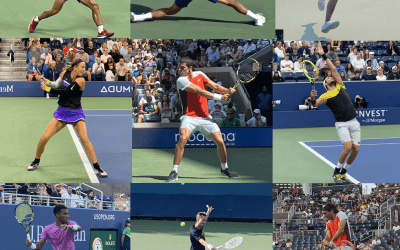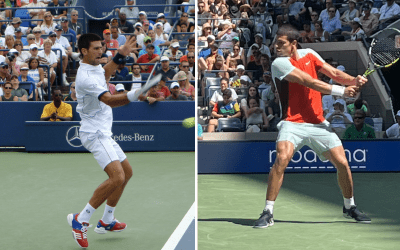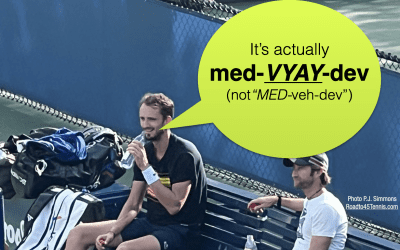10 Tips for Better Doubles Strategy
(Photo: I took this at the 2011 US Open – Austria’s Jurgen Melzer and Germany’s Philipp Petzschner in final set before winning their second Grand Slam doubles title)
Coaches often say that playing doubles strengthens your singles game and vice versa. Having played a lot of doubles over the past year, I couldn’t agree more. Among other things, doubles has quickened up my reflexes and skills at net. It’s also forced me to play smarter and improve my accuracy when placing the ball. And as a USTA competitor, it’s a must-learn skill for most, given that 3 out of 5 courts played for every team match are doubles (unless you’re playing Mixed Doubles, in which case all courts are doubles). I’ve also found doubles to be incredibly fun as you get better and when you find partners you have chemistry with.
 My USTA teammates and I learned a ton about doubles strategy over the past few months from Roger Dowdswell, Tennis Director at Manhattan Plaza Racquet Club. Roger is a former world top-60 player who competed multiple times at Wimbledon, US Open, French Open and the Australian Open. He’s also a wise, classy guy who brings intense but calm energy to practice sessions. One of my teammates recently described Roger as “pretty much the coolest guy on Earth” and I agree. See this great Harper’s profile on Roger, “Courtliness on the Court, and Splendor on the Grass.”
My USTA teammates and I learned a ton about doubles strategy over the past few months from Roger Dowdswell, Tennis Director at Manhattan Plaza Racquet Club. Roger is a former world top-60 player who competed multiple times at Wimbledon, US Open, French Open and the Australian Open. He’s also a wise, classy guy who brings intense but calm energy to practice sessions. One of my teammates recently described Roger as “pretty much the coolest guy on Earth” and I agree. See this great Harper’s profile on Roger, “Courtliness on the Court, and Splendor on the Grass.”
Here are the 10 top takeaways I got from our coaching sessions with Roger:
1) TOUCH AND PLACEMENT ARE FAR MORE IMPORTANT IN DOUBLES THAN KILLING THE BALL–ESPECIALLY WITH VOLLEYS AND OVERHEADS! Getting too “hungry” often just ends up becoming a wristy or swinging shot that ends up in the net or long.
2) GET YOUR FIRST SERVE IN! Roger and so many other pros I’ve worked with emphasize this over and over again for doubles. As soon as you miss your first serve, your opponents get into “attack” mindset (or should!) on your second serve. Take a little pace off to boost your 1st serve percentage. Or consider using a higher-percentage slice serve (versus flat) as your first serve: it may have less pace, but the ball will be trickier for your opponent to handle. The team with the highest 1st serve percentage in doubles has a big advantage. Doubles great Liezel Huber mentions this along with 4 other “Top 5 Doubles Tips” in this USPTA Tennis Resources video.
3) BE CLEAR ON YOUR SHOT CHOICE DURING RETURN OF SERVE. Most often, aim for sharp-angled cross-court returns (medium pace! placement more important than power!) to pull your opposing returner wide. Do this well, and you’ll buy time to move into net, open up the opposing court, and set up you and your partner for a winner.4) VARY THE SPEED AND HEIGHT OF YOUR RETURN OF SERVE– and decide how you’ll return before your opponent serves. Just like volleys and overheads, have a target and strategy in mind before you hit the ball. After seeing your opponent’s serve one game, you’ll probably have a good enough sense of what to expect.
- Option A: Medium-paced short-angled return (to pull opponent at baseline way out wide out)
- Option B: Hard drive
- Option C: Lob (short backswing, usually over opposing net player)
4) TO ATTACK THE OPPOSING NET PLAYER (AND ON APPROACH SHOTS) KEEP THE BALL LOW AND USE MEDIUM-PACE ANGLE SHOTS. If you hit a shot at/near the net player and it’s low, they’ll have to hit up, which means you’ll be able to move into net. And when you hit angle shots, this pulls the opposing teams out of position and buys you time to approach net. Recognize the short balls and opportunities and move into net whenever possible, where most points in doubles are won!
5) ALWAYS HAVE A TARGET IN MIND BEFORE YOU HIT YOUR VOLLEY OR OVERHEAD. Choose a target that buys you some leeway if you’re tight or mishit (i.e., don’t aim for 2 inches from the baseline! Aim for wide boundaries of service line, or opposing net player’s feet, etc).
6) MOVE WITH YOUR PARTNER AND COVER THE MIDDLE! Move with your partner (L and R, up and back–think of “windshield wipers” moving as a unit) and follow the ball. If your partner (or opposing player) is pulled out wide, one of you should be touching the center line of the court with one foot to be covering the middle. There’s only one exception to moving like windshield wipers: if you hit the ball to the middle of the opposing court, you and your partner should move in slightly towards each other to cover the middle.
7) COMMUNICATE, COMMUNICATE, COMMUNICATE– DURING AND BETWEEN EVERY POINT! Talk to each other during every point (You! Me! Go! Stay! etc). And communicate between every point, whether verbally or just physically: whether you talk strategy about the next point, tell your partner “way to go”, or simply give each other a high-five, you’re connecting– a key ingredient to sustained success in the match.
8) THE NET PLAYER SHOULD SIGNAL EVERY TIME BEFORE YOUR PARTNER SERVES (including before the 2d serve)
— Closed fist = “stay”
— Open hand = “poach/switch.”
— (From T-formation) Pinky pointed down = “I’ll move L after you serve”
— (From T-formation) Index finger pointed R = “I’ll move R after you serve”
9) COMMIT TO A POACH/SWITCH AFTER SIGNALING IT. Signaling a poach means you are telling your partner he MUST plan to immediately cover the other side of the court after serving. It does NOT mean you’re going to “try” a poach and stay if not successful. If you signal “stay” and a ball comes into your zip code for a poach, by all means go for it: your partner should be alert to this and move to cover the other side of the court. Important: Once you start signaling and executing poaches, expect the opposing team to start trying to aim more of their returns to your net guy. They will try to go down the line more often and punish you for poaching. As such, the net player should NEVER think “I signaled stay so I can relax now, because they’re probably going to hit their return cross-court…” Instead, the net player should start expecting– actually hoping– that the opposing team hits more shots directly to him. The chances of the net player hitting a winner are far greater than the baseliner.
10) DURING MATCH WARM-UPS, ASK THE OPPONENT YOU’RE WARMING UP WITH TO FEED YOU SOME OVERHEADS: This will both give you time to loosen up your shoulder AND will send a signal to the opposing team that you know what you’re doing 🙂
Next step on my doubles journey is to build in communications/ strategy with my doubles partners around placement of serve, which of course informs choice about whether to poach or not… I’ll keep you posted.
Feel Free to reach out to me directly at roadto45@gmail.com and be sure to follow me on social media!




Love these! On number six, moving like windshield wipers, I have an ongoing disagreement from one of my doubles partners. I have asked several of our club pros and none of them can give us a clear cut answer. When I am receiving serve and pulled way out wide on a sharp angle serve, off the court (sometimes to the fence), my partner does not move to cover the middle. This is leaving the middle of the court completely open and it is impossible for me to run all the way back to cover the down the middle shot. Even… Read more »
Hey Terri, these are all great questions – thanks for laying them out so thoughtfully. I’m just a fellow student myself so hesitate to weigh in… I can see validity in different ideas for different teams/situations and hardly consider myself a doubles expert. A few of the online sources I’ve found particularly insightful for doubles strategy are:
Bill and Matt Previdi (The Previdi System): http://www.theprevidisystem.com
Gigi Fernandez’s doubles TV: http://www.gigifernandeztennis.com/doublestv1.html
Craig O’Shannessy’s Brain Game Tennis: https://www.braingametennis.com
Would love to hear where you end up in your thinking on this! P.J.
This is great “text book” doubles advice. I am playing doubles tomorrow! Thank you!!
Thanks, so glad it’s helpful!! P.J.
I may be ignorant to what is already standard practice, but two things come to mind that I do and rarely see others do in doubles -esp at the HS level. would love others input- The basis is to use the “quick hands” and quick footwork that develops on playing net. 1. On return serve – even first serve, but especially 2nd serve; After you have a feel for where and what type of a serve they have –Come in!! Come as close as possible and aim to make contact with the ball as it comes off the ground so… Read more »
I recently read an article commenting on the Bryan Brothers doubles strategy. They plan unorthodox style that obviously works well for them being the most winningniest doubles partnership in tennis history. What the article said was the Bryan Brothers play more of a football strategy with the guy at the net playing tennis as it he is playing singles, the guy behind is watching every move his partner makes an instantly shifting right or left with his front partners moves. The guy playing back is like a safety role in football. I tried this technique with a guy who was… Read more »
As a 3.0 net player who plays the ad side of the court I am totally confused on when should I cover the line and when should I cover the middle
Advise pls
Hi there, I can only tell you what I hear most is expressed in #7 above: you and your partner should focus most of the time on covering (“pinching”) the middle because a down-the-line shot from your opponent is a lower-percentage shot; they may get it past a few times, but they’re much more likely to pass you down the middle if you are trying to hard to cover the line. Above all, move with your partner like you were tied together with an invisible band — i.e. if s/he gets pulled out wide in one direction, move in the… Read more »
Hi,
I finally met someone that has the same goal. This is funny….I was told I’m a 4.0 and I can potentially be a 5.0 but 4.5 is really possible. I just need a good roadmap.
Stay in touch
Eric
Hey Eric, great to meet you! Let’s both keep shooting for 5.0, but 4.5 as the next milestone in the nearer term :). Let me know if you ever want to do a guest post on your experiences on “the road!” PJ
Aloha! Found this page while searching for doubles tips. Thanks for the helpful guidance -hope I can apply them with success in my two matches tomorrow.
Aloha! Have fun tomorrow and go get em! PJ
This is good info. I have seen some other sites that provide some really confusing tips that are probably more for 4.5 or better team. My team is 3.5 and we have no set strategy but change it during the game.
exactly, i found this post very informative. Really a good source. Thanks!
hey what is your fb page?
Hey Alektos, FB page is http://www.facebook.com/roadto45